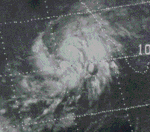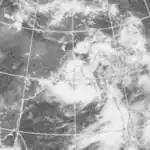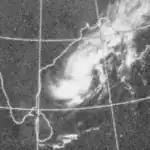| 1975 North Indian Ocean cyclone season | |
|---|---|
 Season summary map | |
| Seasonal boundaries | |
| First system formed | January 6, 1975 |
| Last system dissipated | December 20, 1975 |
| Seasonal statistics | |
| Depressions | 20 |
| Cyclonic storms | 7 |
| Severe cyclonic storms | 4 |
| Total fatalities | Unknown |
| Total damage | Unknown |
| Related articles | |
The 1975 North Indian Ocean cyclone season was part of the annual cycle of tropical cyclone formation. The season has no official bounds but cyclones tend to form between April and December. These dates conventionally delimit the period of each year when most tropical cyclones form in the northern Indian Ocean. There are two main seas in the North Indian Ocean—the Bay of Bengal to the east of the Indian subcontinent and the Arabian Sea to the west of India. The official Regional Specialized Meteorological Centre in this basin is the India Meteorological Department (IMD), while the Joint Typhoon Warning Center (JTWC) releases unofficial advisories. An average of five tropical cyclones form in the North Indian Ocean every season with peaks in May and November.[1] Cyclones occurring between the meridians 45°E and 100°E are included in the season by the IMD.[2]
Systems
Tropical Storm One (01B)
| Depression (IMD) | |
| Tropical storm (SSHWS) | |
  | |
| Duration | January 6 – January 10 |
|---|---|
| Peak intensity | 45 km/h (30 mph) (3-min); |
Cyclone Two (02A)
| Extremely severe cyclonic storm (IMD) | |
| Category 2 tropical cyclone (SSHWS) | |
  | |
| Duration | May 1 – May 10 |
|---|---|
| Peak intensity | 185 km/h (115 mph) (3-min); |
Two meandered slowly northwest, attaining hurricane-force winds between May 3 and May 5. The cyclone dissipated before making landfall.
Cyclone Three (03B)
| Very severe cyclonic storm (IMD) | |
| Category 1 tropical cyclone (SSHWS) | |
  | |
| Duration | May 4 – May 8 |
|---|---|
| Peak intensity | 150 km/h (90 mph) (3-min); |
On May 5, Cyclone Three formed offshore of Thailand before recurving into Burma on May 7 as a hurricane-force system. Three moved inland and dissipated on May 8.
Tropical Storm Five (05B)
| Deep depression (IMD) | |
| Tropical storm (SSHWS) | |
  | |
| Duration | June 4 – June 7 |
|---|---|
| Peak intensity | 55 km/h (35 mph) (3-min); |
Cyclone Sixteen (16A)
| Very severe cyclonic storm (IMD) | |
| Category 1 tropical cyclone (SSHWS) | |
  | |
| Duration | October 19 – October 24 |
|---|---|
| Peak intensity | 155 km/h (100 mph) (3-min); |
Cyclone Sixteen formed on 19 October and began to intensify, peaking as a Very Severe Cyclonic Storm or as a Category-1 equivalent storm on October 21. The storm made landfall at Porbandar in Gujarat at peak intensity. Sixteen dissipated on October 24.
The cyclone caused severe damage to livelihoods, killing 85 people. Total damages in Indian Rupees were estimated to be 75 crores.
Tropical Storm Eighteen (18B)
| Cyclonic storm (IMD) | |
| Tropical storm (SSHWS) | |
  | |
| Duration | November 1 – November 3 |
|---|---|
| Peak intensity | 65 km/h (40 mph) (3-min); |
Tropical Storm Nineteen (19B)
| Severe cyclonic storm (IMD) | |
| Tropical storm (SSHWS) | |
  | |
| Duration | November 7 – November 12 |
|---|---|
| Peak intensity | 100 km/h (65 mph) (3-min); |
Tropical Storm Twenty (20B)
| Cyclonic storm (IMD) | |
| Tropical storm (SSHWS) | |
  | |
| Duration | November 24 – December 2 |
|---|---|
| Peak intensity | 75 km/h (45 mph) (3-min); |
See also
- North Indian Ocean tropical cyclone
- 1975 Atlantic hurricane season
- 1975 Pacific hurricane season
- 1975 Pacific typhoon season
- Australian cyclone seasons: 1974–75, 1975–76
- South Pacific cyclone seasons: 1974–75, 1975–76
- South-West Indian Ocean cyclone seasons: 1974–75, 1975–76
References
- ↑ "Frequently Asked Questions: What is the annual frequency of Cyclones over the Indian Seas? What is its intra-annual variation?". India Meteorological Department. 2012. Archived from the original on May 21, 2015. Retrieved June 8, 2012.
- ↑ "Bulletins Issued by Regional Specialized Meteorological Centre (RSMC) – Tropical Cyclones, New Delhi" (PDF). India Meteorological Department. May 25, 2009. Archived from the original (PDF) on 2012-04-12. Retrieved July 16, 2012.
External links
- India Meteorological Department
- Joint Typhoon Warning Center Archived 2015-08-09 at the Wayback Machine